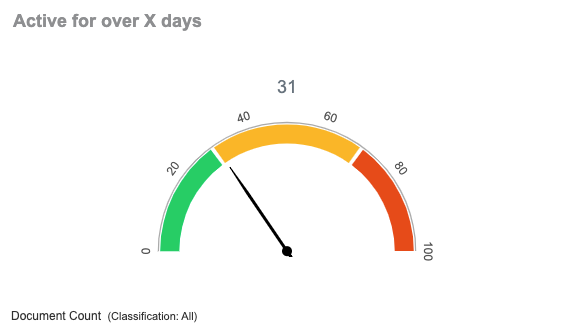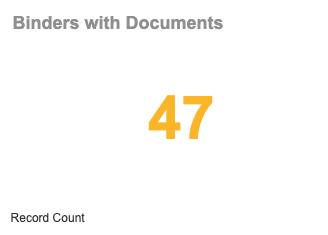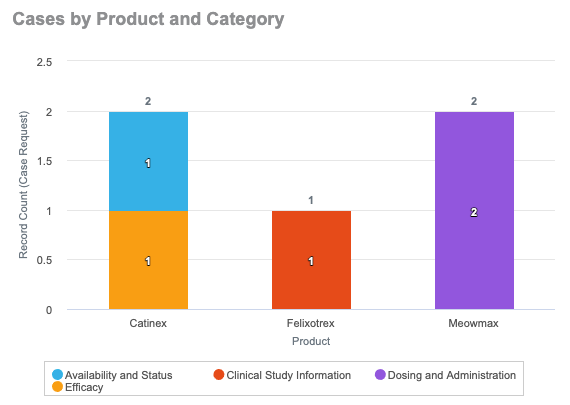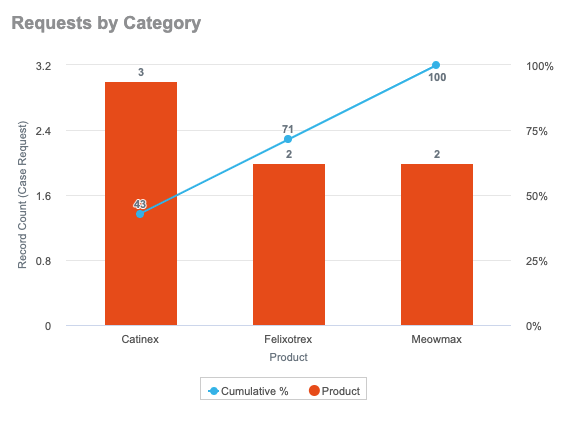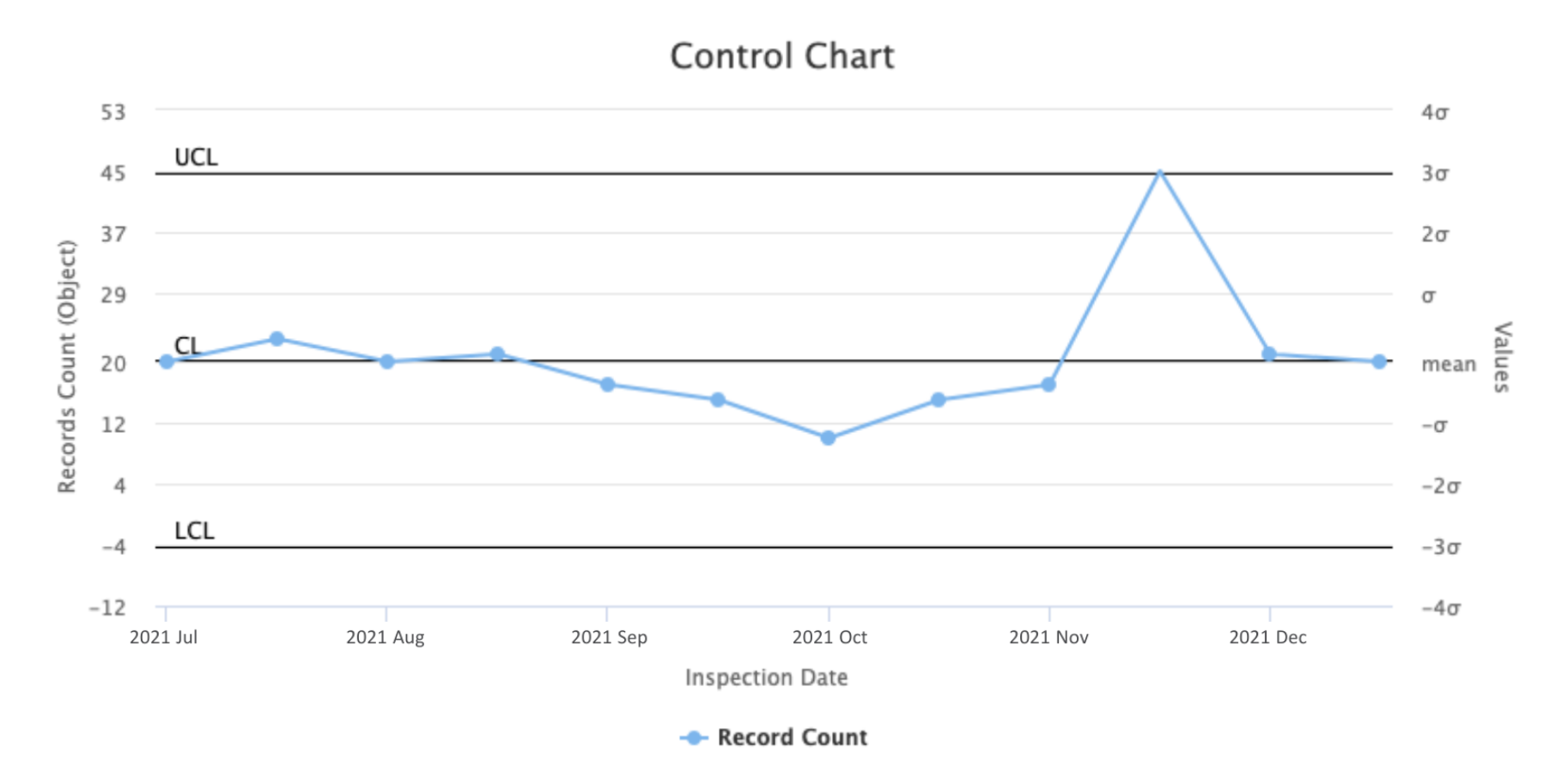Dashboards provide an at-a-glance understanding of key metrics. Each dashboard contains one or more dashboard components and each component displays metrics from a report.
Dashboard Resizing
To create a new dashboard:
- From the Dashboard tab, click Create to open the builder.
- Click Add Component and set options in the Add New Component dialog. Review the component settings for each chart type: Gauge, Number, Column, Pareto, Bar, Line, Pie, and Control.
- Repeat the process to create as many components as you need to display on the dashboard. You can add up to 15 components.
- Rearrange components by clicking on the component and dragging it to the new location.
- Resize components by clicking the arrow in the bottom-right and dragging the component to your desired size. Vault allows up to three (3) components in a single horizontal row.
- Click Save & Run.
Using Run-Time Inputs with Dashboards
Run-time inputs allow dashboard viewers to dynamically update a dashboard to show information most relevant to them. For example, a PromoMats organization uses a dashboard with components that measure average approval time and number of review cycles. This dashboard is shared across the organization, but individual users who access the dashboard can use run-time inputs to filter on specific products or therapeutic areas.
Vault remembers your filter settings when you leave and return to the dashboard. The same filter will be applied each time you rerun the dashboard. To change your filter preference, click the Edit icon next to Filters in the upper left of the dashboard window.
To use run-time inputs with dashboards, select a report with run-time inputs when creating a dashboard component. When running dashboards, users enter run-time filter values to use in the dashboards. Vault combines run-time filters that reference the same object and use the same operator. For example, the Study > Country in… and Document > Country in… prompts both reference the Country object and use the in operator, so users will only select a Country once. The filter values are based on the associated prompt report filters. Users can also choose to skip optional filter prompts when configured.
How to Copy Dashboards
If you want to create a dashboard that shares components with another dashboard, you can copy the existing dashboard. You must be the dashboard’s owner or have the Editor role to copy.
To copy a dashboard:
- From the Dashboards tab or from inside a specific dashboard, click on the Actions menu and choose Make a Copy.
- Enter a Name and (optional) Description for the new dashboard.
- Click Continue.
- Make any necessary edits to the new dashboard. When finished, click Save or Save & Run.
How to Edit Dashboards
Only the dashboard owner, a user listed as Editor for the dashboard, or an Admin can edit a dashboard. To open edit mode, open the dashboard and click Edit. When finished, click Save or Save & Run. From edit mode, you can:
- Rename or edit the dashboard component by clicking by the dashboard name. Review the component settings for each chart type: Gauge, Number, Column, Pareto, Bar, Line, and Pie.
- Delete a dashboard component by clicking by the component name.
- Rearrange dashboard components by clicking on the component and dragging it to a new location in the dashboard.
- Add a new component by clicking Add Component.
- Expand and resize dashboard components by clicking the arrow in the bottom-right and dragging the component to your desired size. Vault allows up to three (3) components in a single horizontal row.
How to Create Gauge Charts
To create a dashboard component that shows a gauge chart:
- While in edit mode, click Add Component.
- Enter a Name for the component.
- Select a Report.
- On the Chart Data tab, select Gauge as the chart type, if available. Vault determines the available chart types based on the data in the selected report.
- Select a metric from the report to serve as the data for the chart. If the report uses grouping, choose whether to include all groups or select specific groups.
- On the Formatting tab, enter the range of metric values to show on the chart. If you want the exact metric value to appear below the chart, select Display Actual Value and enter the unit label. Select the Display Metric Label checkbox to show the name of the metric in the chart. Select the Display Groupings checkbox to show details for the groupings applied to the chart. You can also add up to three colored bands to the chart by selecting a color and an end value for the band.
- Click Continue to add the new component to the dashboard.
This example shows a gauge chart.
How to Create Number Charts
To create a dashboard component that shows a number chart:
- While in edit mode, click Add Component.
- Enter a Name for the component.
- Select a Report.
- On the Chart Data tab, select Number as the chart type, if available. Vault determines the available chart types based on the data in the selected report.
- Select a metric from the report to serve as the data for the chart.
- Select All Values or choose a specific grouping (only available for grouped reports).
- Optional: Select the % of Grand Total checkbox to display this chart as a percentage. This is only available if your metric is a sum or count and the chart shows a specific grouping.
- On the Formatting tab, enter a unit label for the number. If you want the number to show in a specific color, depending on the value, use the range selectors to choose a color and enter the start/end values for the range. The ranges must be in ascending order, meaning that Range 1 must be lower numbers than Range 2.
- Click Continue to add the new component to the dashboard.
This example shows a number chart.
How to Create Bar Charts
To create a dashboard component that shows a bar chart:
- While in edit mode, click Add Component.
- Enter a Name for the component.
- Select a Report.
- On the Chart Data tab, select Bar as the chart type, if available. Vault determines the available chart types based on the data in the selected report.
- Select a metric (x-axis value) from that report to serve as the data for the chart. In Y-Axis (Category), select a field to serve as category in the report. In Group By, select a field to group by within each category. Select Stacked, Grouped, or % Stacked as the Group Styling.
- On the Formatting tab, choose to show or hide the x and y axis labels. Modify the labels if needed. Select the Show Chart Values checkbox to display the exact value for each category or group after the bar. Select the Show Legend checkbox to display a legend below the chart. Enter a value for Target Line if you want to display a target value as a line on the chart.
- Click Preview Report Data to preview the chart with data.
- Click Continue to add the new component to the dashboard.
This example shows a bar chart using the “Grouped bar” grouping style.
How to Create Column Charts
To create a dashboard component that shows a column chart:
- While in edit mode, click Add Component.
- Enter a Name for the component.
- Select a Report.
- On the Chart Data tab, select Column as the chart type, if available. Vault determines the available chart types based on the data in the selected report.
- Select a metric (y-axis value) from that report to serve as the data for the chart. In X-Axis (Category), select a field to serve as category in the report. In Group By, select a field to group by within each category. Select Stacked, Grouped, or % Stacked as the Group Styling.
- On the Formatting tab, choose to show or hide the x and y axis labels. Modify the labels if needed. Select the Show Chart Values checkbox to display the exact value for each category or group above the column. Select the Show Legend checkbox to display a legend below the chart. Enter a value for Target Line if you want to display a target value as a line on the chart.
- Click Preview Report Data to preview the chart with data.
- Click Continue to add the new component to the dashboard.
This example shows a column chart using the “Stacked columns” grouping style.
How to Create Pareto Charts
To create a dashboard component that shows a pareto chart:
- While in edit mode, click Add Component.
- Enter a Name for the component.
- Select a Report.
- On the Chart Data tab, select Pareto as the chart type, if available. Vault determines the available chart types based on the data in the selected report.
- Select a metric (y-axis value) from that report to serve as the data for the chart. Only reports with groups can be used for pareto charts. In X-Axis (Category), select a field to serve as category in the report. If the report has a single grouping, this will be the X-Axis.
- On the Formatting tab, choose to show or hide the x and y axis labels. Modify the labels if needed. Select the Show Chart Values checkbox to display the exact value for each category or group above the column. Select the Show Legend checkbox to display a legend below the chart. Enter a value for Target Line if you want to display a target value as a line on the chart.
- Click Preview Report Data to preview the chart with data.
- Click Continue to add the new component to the dashboard.
How to Create Line Charts
To create a dashboard component that shows a line chart:
- While in edit mode, click Add Component.
- Enter a Name for the component.
- Select a Report.
- On the Chart Data tab, select Line as the chart type, if available. Vault determines the available chart types based on the data in the selected report.
- Select a Metric (y-axis value) from that report to serve as the data for the chart. In X-Axis (Category), select a field to serve as the category in the report. In Group By, select a field to group by within each category, if available.
- On the Formatting tab, choose to show or hide the x- and y-axis labels. Modify the labels if needed. Select the Show Chart Values checkbox to display the exact value for each category or group above the data point on the line. Select the Show Legend checkbox to display a legend below the chart. Enter a value for Target Line if you want to display a target value as a line on the chart.
- Click Preview Report Data to preview the chart with data.
- Click Continue to add the new component to the dashboard.
This example shows a line chart.
How to Create Pie Charts
To create a dashboard component that shows a pie chart:
- While in edit mode, click Add Component.
- Enter a Name for the component.
- Select a Report.
- On the Chart Data tab, select Pie as the chart type, if available. Vault determines the available chart types based on the data in the selected report.
- Select a metric from that report to serve as the data for the chart. In Group By, select a field to group by within each category.
- On the Formatting tab, select the Show Category Labels checkbox to display the labels for each grouping category. Select Show Percentages to display the percentage for each grouping category. Select the Show Legend checkbox to display a legend below the chart.
- Click Preview Report Data to preview the chart with data.
- Click Continue to add the new component to the dashboard.
This example shows a pie chart.
How to Create Control Charts
To create a dashboard component that shows a control chart:
- While in edit mode, click Add Component.
- Enter a Name for the component.
- Select a Report.
- On the Chart Data tab, select Control as the chart type, if available. Vault determines the available chart types based on the data in the selected report.
- Select a Metric (y-axis value) from that report to serve as the data for the chart. Vault performs all sigma calculations automatically. In X-Axis (Category), select a field to serve as the category in the report.
- On the Formatting tab, choose to show or hide the x- and y-axis labels. Modify the labels if needed. Select the Show Chart Values checkbox to display the exact value for each category or group above the data point on the line. Select the Show Legend checkbox to display a legend below the chart. Enter a value for the Target Line if you want to display a target value as a line on the chart.
- Click Preview Report Data to preview the chart with data.
- Click Continue to add the new component to the dashboard.
This example shows a control chart.
Limits for Reports
- For Gauge and Number charts, you can use any report except a matrix report that groups on a Date or DateTime field. For other charts, you can use any report that uses grouping, but not a report that is ungrouped.
- Reports that use Show as % as a grouping option cannot be used on dashboards.
- Vault does not support ladder reports on dashboards.
The following table offers a visual representation of supported charts for various report formats:
| Chart Types | ||||||||
|---|---|---|---|---|---|---|---|---|
| Gauge | Number | Column | Bar | Line | Pie | Control | ||
| Report Format | No Groups | X | X | |||||
| Grouped by Date field | X | X | X | X | X | |||
| Grouped by non-Date field | X | X | X | X | X | X | X | |
